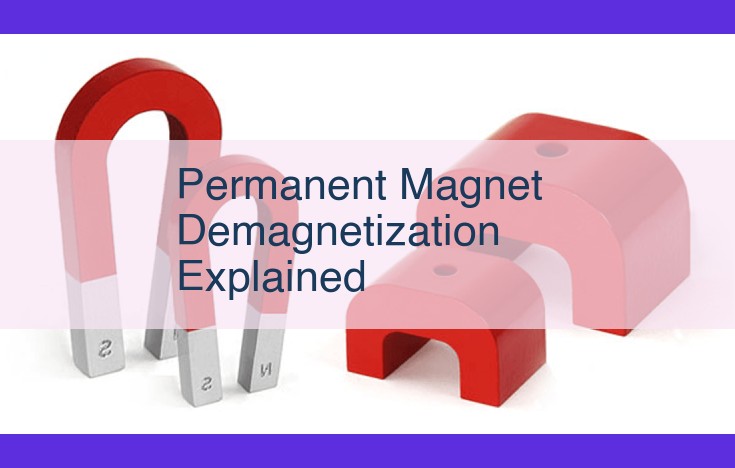Understanding Permanent Magnet Demagnetization: Causes, Effects, And Mitigation
Permanent magnet demagnetization occurs when a magnet loses its magnetic strength. The hysteresis loop, a graphical representation of the magnet’s magnetization and demagnetization, explains this behavior. Factors like temperature, shock, and corrosion contribute to demagnetization. The Curie temperature, above which the magnet becomes non-magnetic, is important. Demagnetization involves intentionally reducing the magnet’s strength, distinct from degaussing, which completely eliminates it. The demagnetization curve shows the gradual loss of magnetism. The hysteresis loop concept highlights the magnet’s ability to retain its magnetism after being magnetized.
Understanding Demagnetization: The Hysteresis Loop
In the realm of magnetism, the phenomenon of demagnetization holds a peculiar yet significant place. It refers to the process by which a permanent magnet loses its magnetic strength. comprender this counterintuitive phenomenon, we must delve into the intricate world of the hysteresis loop.
The Hysteresis Loop
Imagine a line graph charting the magnetization of a permanent magnet as it undergoes changes in external magnetic fields. This graph, known as the hysteresis loop, reveals a fascinating tale of magnetic behavior.
Initially, as the magnet is exposed to an increasing magnetic field, its magnetization increases in a linear fashion. However, a point is reached where the magnet becomes saturated with magnetism. Beyond this point, the magnetization increase becomes gradual.
When the external magnetic field is gradually reduced, the magnet’s magnetization does not retrace its path. Instead, it follows a different curve, exhibiting a coercive force that opposes demagnetization. This coercive force, measured in oersteds (Oe), determines the magnet’s resistance to demagnetization.
Factors Contributing to Demagnetization
The demagnetization of permanent magnets can be influenced by various factors:
-
Temperature: As a magnet’s temperature rises, its magnetic strength decreases. Each magnet has a specific Curie temperature above which it loses all residual magnetism.
-
Mechanical Shock: A sudden mechanical impact can disrupt the alignment of magnetic domains within the magnet, leading to demagnetization.
-
Corrosion: Chemical reactions that create a non-magnetic layer on the magnet’s surface can contribute to demagnetization.
-
Time: Over time, even in the absence of external factors, permanent magnets gradually lose their strength due to thermal fluctuations and interactions with ambient magnetic fields.
Additional Key Concepts
-
Demagnetization Curve: This curve represents the relationship between the magnetic field strength required to demagnetize a magnet and the magnet’s current magnetization.
-
Degaussing: Unlike demagnetization, degaussing involves intentionally exposing a magnet to a strong alternating current magnetic field to remove all residual magnetism.
-
Hysteresis Loop Implications: The shape of the hysteresis loop provides valuable insights into the magnetic properties of a permanent magnet, including its coercivity, remanence, and saturation magnetization.
The hysteresis loop offers a profound understanding of demagnetization, revealing the intricate interplay between magnetic fields and the internal structure of permanent magnets. By comprehending the factors that influence demagnetization, we can design and utilize permanent magnets effectively in a wide range of applications.
Factors Contributing to Demagnetization
Permanent magnets are indispensable in our daily lives, powering everything from tiny motors to powerful generators. However, these magnets are not immune to the relentless forces of nature that can gradually diminish their magnetic strength. Understanding these factors is crucial for preserving the integrity of permanent magnets in various applications.
Temperature: A Delicate Balancing Act
Temperature plays a pivotal role in the magnetism of permanent magnets. As the temperature rises, the thermal energy imparted to the magnet’s atoms increases, causing their magnetic alignment to become more chaotic. This disruption leads to a gradual decrease in the magnet’s strength. Conversely, cooling a magnet can enhance its magnetism by reducing thermal energy and promoting a more ordered magnetic structure.
Mechanical Shock: A Rude Awakening
Mechanical shock, such as sudden impacts or vibrations, can also have a detrimental effect on permanent magnets. The forceful jostling can disrupt the magnetic alignment of the material, resulting in partial or complete demagnetization. This is particularly concerning in applications where magnets are subjected to repeated or intense vibrations.
Corrosion: A Silent Thief
Corrosion, the insidious enemy of metallic materials, can also wreak havoc on permanent magnets. As the magnet’s surface deteriorates due to oxidation or other chemical reactions, the magnetic properties can be compromised. Corrosion can create microscopic pits and cracks that disrupt the flow of magnetic forces, leading to a gradual loss of strength.
Time: The Unrelenting Adversary
Time, the most relentless of all forces, exerts a subtle but steady influence on permanent magnets. Over time, the magnetic domains within the material can slowly rearrange themselves, resulting in a gradual decrease in magnetization. This effect is more pronounced in weaker magnets and can be accelerated by exposure to heat or other adverse conditions.
Additional Related Concepts
Curie Temperature
Every material has a specific temperature, called the Curie temperature, beyond which it loses its magnetic properties. When a permanent magnet is heated above its Curie temperature, it becomes demagnetized. This temperature is crucial for understanding the stability and performance of permanent magnets.
Demagnetization vs. Degaussing
While both terms refer to the process of reducing a magnet’s strength, they differ in mechanism. Demagnetization occurs gradually over time due to various factors like temperature, shock, or corrosion. Conversely, degaussing is an intentional, controlled process that rapidly demagnetizes a magnet using a strong electromagnetic field.
Demagnetization Curve
The demagnetization curve graphically depicts the relationship between the applied magnetic field and the magnetization of a material. This curve provides insights into the magnet’s demagnetization behavior and its resistance to external magnetic fields.
Hysteresis Loop
The hysteresis loop is a graphical representation of a magnet’s magnetization and demagnetization cycle. It shows the relationship between the applied magnetic field and the magnet’s magnetization strength. The loop’s shape and characteristics provide valuable information about the magnet’s stability and the energy required to magnetize and demagnetize it.
Implications for Permanent Magnets
Understanding these concepts is critical for designing and using permanent magnets effectively. By considering factors like the Curie temperature, demagnetization mechanisms, and the hysteresis loop, engineers can optimize magnet performance, enhance longevity, and minimize unintended demagnetization events.
